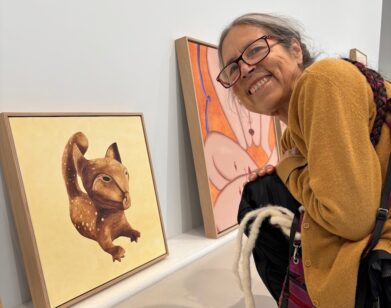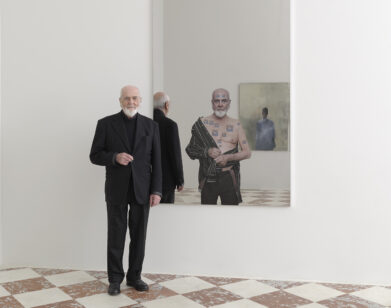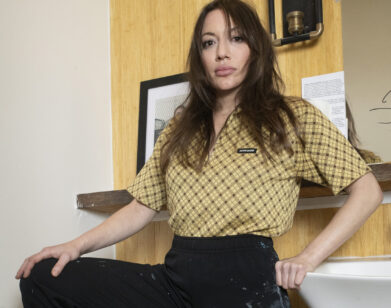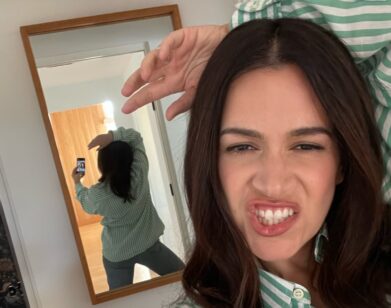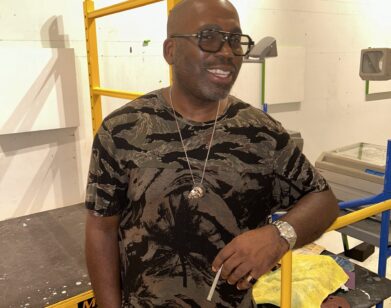Mike Perry Has Always Been an Indoor Kid
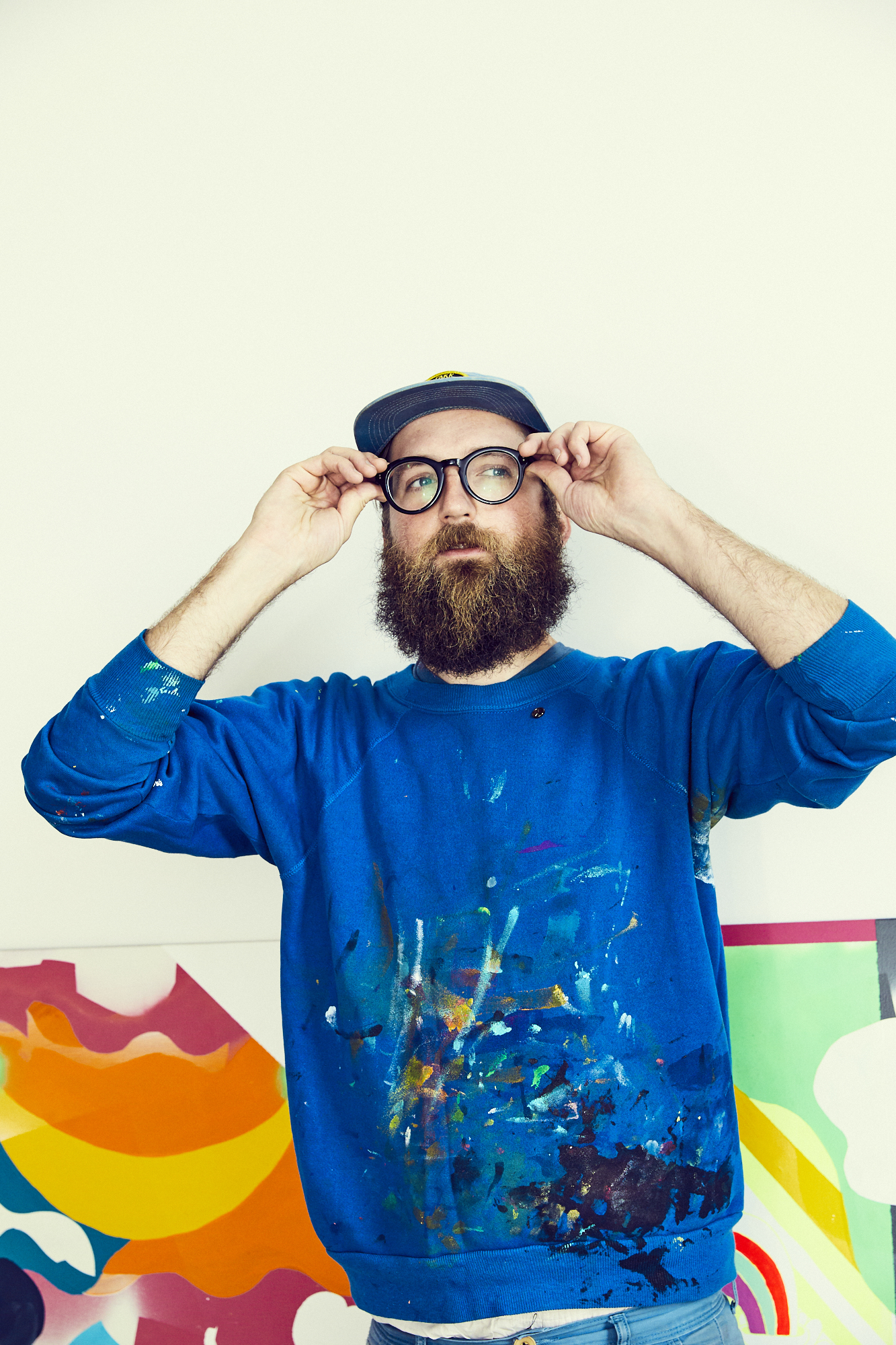
Photo by Meredith Jenks.
As extroverted New Yorkers grapple with how to wait out a global pandemic from the isolated confines of their apartments, the multimedia artist Mike Perry remains undaunted by solitude. Perry, best known for his Emmy-winning animations for Comedy Central’s Broad City, has cultivated an aesthetic reflective of his ever-optimistic outlook and explosive imagination.
His drawings, paintings, prints, animations, and sculptures are chock full of eccentric scenes. Cartoon creatures with duck-bill mouths, gummy fingers, and ecstatic eyeballs sip dry martinis. Wiggly floral beings wind their limbs across urban landscapes as houses come alive. Hot pink nipples poke up through the concrete, multicolored tornadoes occasionally rolling through. Perry’s world, it seems, is a Day-Glo Bacchanalian banquet, where anyone can throw their feet up on the table, and the meal, too, has a mind of its own.
The artist’s latest exhibition, a mini-golf experience called “Putt and Ponder” located inside his Crown Heights studio, invites the public to engage with his penchant for weirdness. While the show, originally set to open March 21st, remains temporarily closed, the wonky indoor course is serving as a set for a series of Instagram livestreams. There, Perry has been responding to call-in questions from his audience of primarily artists, brainstorming ways to help others amidst the health crisis.
Interview called up Perry at home to talk about miniature golf, his love for New Yorkers, and his lifelong knack for evading boredom.
———
MIKE PERRY: Bonjour.
ELLA HUZENIS: Hi, this is Ella with Interview.
PERRY: Yo, what’s happening? I just say “Bonjour,” because if it’s a robot, they don’t know what’s happening. They don’t know what to do. They’re like, “This isn’t real. This is another robot.” Anyway, thank you so much for reaching out. Obviously, I’m a massive fan of the Interview universe. It was definitely one of those magazines that my dad always subscribed to.
HUZENIS: I’m happy to hear you’re a reader.
PERRY: Yeah. My wife and I do a magazine. It’s called Tidal. It’s just the idea of artists talking. Self-publishing is so important. Like, If the mainstream doesn’t want to support these ideas, maybe we just have to take to our own platforms and figure out how to get our ideas out there? And that’s what Andy [Warhol] was doing from the beginning.
HUZENIS: How long have you been involved in Tidal?
PERRY: I think we’re working on issue 13 right now. And it’s twice a year .. So that’s six years, I guess now. My wife started it. It’s her magazine, but the benefit of being the life partner is that you’re in from the beginning. So it’s been a long-term conversation. But it’s definitely her show. I’m just like a tool. She uses me. I use my graphic design skills and let her run the show.
HUZENIS: Is this the first project you’ve worked on together?
PERRY: No. We actually met a long ass time ago. I used to work for Urban Outfitters as an art director, back in like 2003 or something. We shot this catalogue and hired this photographer; her name was Anna Wolfe. We were on this shoot, and we just hit it off. We just instantly became BFFs, like immediately. She was living in New York, and I was living in Philadelphia, and it came to that time in every long-distance relationship, where it’s like, “Do we commit to this? And does one person move, or the other person move?” We kind of rolled the dice, and it ended with me coming to New York. Philly’s amazing. It was an incredible place to live, but I’m such a New Yorker. It’s out of control. I love it so much.
HUZENIS: So you grew up in Missouri, moved to Kansas in high school, went to college in Minnesota, and worked in Philadelphia, all before coming to New York.
PERRY: Yeah. I grew up crazy rural. And now here I am in the biggest city. When I was a kid in the Midwest, everyone was like, “The city is so scary, and dangerous, and there’s no community,” and then I moved to New York, and I’m like, “Oh my god.” Number one, it’s all community. It is community in a way that people that only drive cars around can’t even imagine, because when you’re on the street and you see people, and you see them every day, they become your neighbors. And I think the community of the city is really what keeps me here. It’s just freaking incredible.
HUZENIS: Recently, many of your posts on Instagram have addressed the public health crisis. Tell me about your efforts to get involved.
PERRY: I know that there are a lot of people out there that are not in a situation like I am, and so I think it’s just my responsibility to do anything I can do. I’m not a scientist. I make drawings. I’m an optimist, and I’ve always been an optimist. So my role right now is to just try to be really positive for people that maybe need a little positivity, and do whatever I can do to give back and help.
Artists—we’re just natural makers, and, weirdly, also really good at spending a lot of time alone. Making a painting that takes a month or two is kind of like pretty normal, where you just don’t really do much, and you’re just by yourself. Not everyone does that, and most people don’t want that. I mean, it’s so interesting how all of my friends that are hyper-hyper-social are the ones that are kind of trying to figure this out the most.
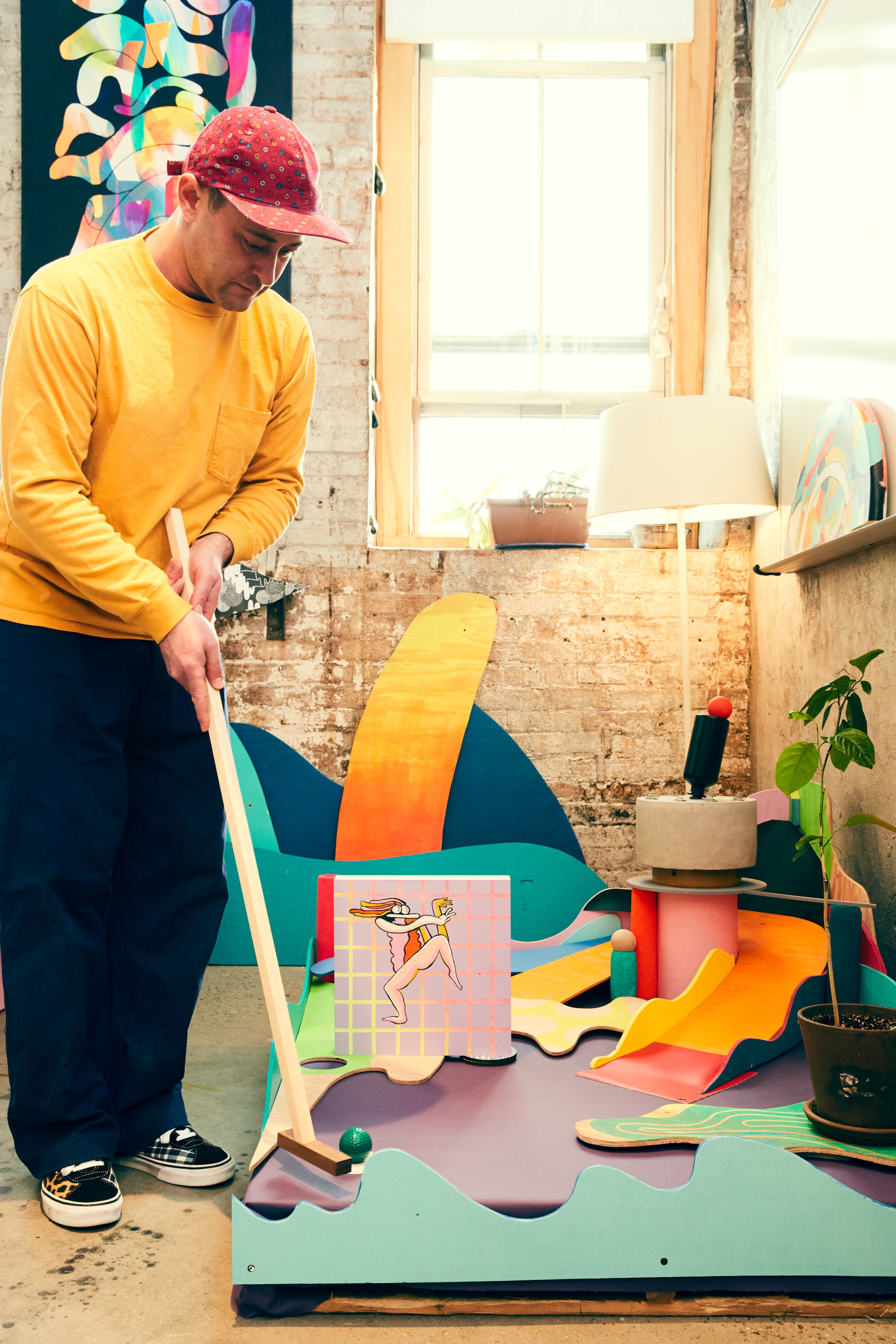
From “Putt & Ponder.”
HUZENIS: How did you conceive of “Putt & Ponder,” and what’s going on with the mini-golf course now that it’s closed?
PERRY: As a studio, we’re massively into recycling. It’s one of the most upfront philosophies that we have, and that goes to the point of really being conscious with our materials and making sure that the things that we make have a life that doesn’t turn into garbage. We basically we were like, “Okay, we want to do a big exhibition. We have this extra space right now. Let’s use this space, and use all of these resources that we have. Let’s make a miniature golf course.” And both J [Bell, Director of Craft at Mike Perry Studio] and I accidentally had the idea at the same time. Like, boom. We had that shared “eureka” moment.
We kind of tried to design the experience around the idea of indoor/outdoor. So the idea is that you start inside. You basically enter into the building, and you’re greeted by the first hole. It’s this surrealist take on an indoor space. So there’s a desk, and there’s a kitchen table, and then there’s a counter with a sink on it. There’s a bookshelf that has a hole. There’s a vanity that you can sit at and play the hole. There’s this whole inside vibe, but then one of the holes actually kicks the ball “outside,” so you actually have to go into the “outdoor” space in order to continue your game. You’re trying to create some sort of narrative, but also a navigable path for the user to travel through the experience that just makes it more fun and wild.
Once you’re “outside,” there’s an alligator pit. That’s what I’m calling it. There’s not a fountain, but we can still play with the idea of that. We’re like, “We’ll just make these things that we’ll just call it the alligator pit, and make a fake version of water … Let’s get into it.” There’s a spaceship hole that I love. It just looks like what I would say would be a cool spaceship. Each one’s unique and weird, but they all talk to each other.
It’s funny, it’s like as soon as this shit hit, it’s not like me and my wife were like, “Oh, let’s go play miniature golf.” It’s like, “let’s refocus our energies and make sure that we can do what actually needs to be done right now.” So I did a live call in show last Sunday [March 22nd]. I was just like, “Let’s just do it from the exhibition because the exhibition was supposed to open on Saturday, and it looks like a crazy set.” I mean, it looks like Peewee’s Playhouse. It’s fucking weird. Let’s take advantage of it, because we have it built. We might as well just go for it, and keep it going. Let’s just talk to artists. Let’s have a conversation, because this is what we need to do right now.
HUZENIS: You also took the initiative to hand out sketchbook kits to kids in your community without access to art supplies. Are you interested in inspiring young people to pursue art right now?
PERRY: I was an indoor kid from the beginning. So drawing was such a sanctuary for my life as a kid. It was a safe place for me to go and use my imagination, and there’s so many kids out there that just don’t have supplies.
HUZENIS: What was your relationship with art like as a child?
PERRY: It was everything. You know, it was one of those things where I didn’t draw, and then one day my mom bought me this set of colored pencil and a little sketchbook, and then all of a sudden I was a drawer. Nonstop. I don’t really have any real memories of not drawing. I’d go to church with my grandma, and she would always bring a pad of paper, and I would just sit there and do my drawings.
It was so liberating, but so fearful. I just remember, I’d do a drawing, and then I’d just be like, “Oh, this is so bad,” and I would rip it out of my book and crumple it up. Like, you’re at the beginning of the Malcolm Gladwell “10,000 hours.” You’re like, hour one, start … So you’re going to feel like, “Oh, I can’t do this, I can’t do this.” And then you just keep doing it.
HUZENIS: So you began with drawing and then found your way into other media?
PERRY: Yeah, drawing was the way to do it. I did the kid thing where I just drew cartoons. I drew Bugs Bunny and Marvin the Martian all the time. That was my jam. Then I became a teenager and did all these angsty drawings of like, who knows? Heartache, probably? Just like, “Oh, I’m 13, and the world is painful.”
I had a grandfather who I didn’t really have a relationship with, but he was a painter. He lived in the middle of nowhere, in Missouri. He made his money off of junking things, and he gave me a tackle box full of oil paints when I was 14 for my birthday. It was all used stuff that he just had in the studio. He probably was like, “Oh shit, I’ve got to get this kid a present,” and he went through his shed and pulled a bunch of old paints and threw it in a box.
He gave it to me, and I remember just exploding. I was on fire. I was like, “Holy shit. This is what I’ve been missing.” I would paint on anything. I would go find trash. Someone threw out a refrigerator, and I remember just taking the refrigerator door off and dragging it to my basement, and painting on it. It was not about the work. It was about just being inspired.
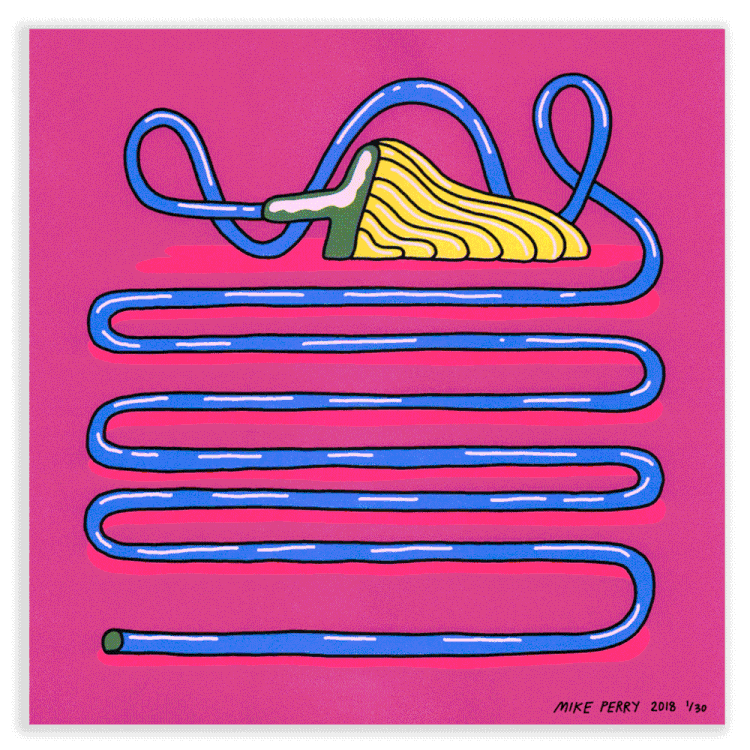
HUZENIS: Were your friends as passionate about art during that time?
PERRY: It’s interesting, I had two high school experiences. I went to one high school that didn’t really have an art program, and then my mom got remarried, and we moved to a different school, and the school had an incredible art program. So at that school, there were all these art kids, but this one kid showed up, Mark, who had moved from Baltimore. Mark was a painter, and he was such a badass. He was a little dangerous, and I was just a fucking nerd. But Mark and I started hanging out. I mean, the first time I ever smoked weed was with Mark. Mark was that kind of guy. He was cool because he was from the East Coast. I remember him showing me Shepard Fairey in, like, ’96. It’s crazy. And so he became my pretty close art buddy.
But when I was in middle school, my best friend—his name was Matt—he was an artist too. We spent so much time drawing, and we played a lot of Dungeons & Dragons, which I think ultimately was really amazing for imagination building, storytelling. Artists stick together. This is how it works. It’s weird. We all find each other.
HUZENIS: You talked about how comfortable artists are with spending time alone. Do you think of yourself as an introvert? Or is that just a function of your profession?
PERRY: I don’t know much about astrology, and I’m definitely not a—I don’t know what you would call it. Like, a “fan?” But I have looked into my sign, and I’m a Cancer on the Leo cusp. So I like to think I’m really good at hiding and being in my shell, and quiet. But then because I have this lion inside of me. I genuinely love people. I’m into them, in so many ways. I think it works for me. I’ve been giving a lot of pep talks lately, and I’m so grateful that I have this skill because people need it sometimes.
HUZENIS: What are you looking forward to, once this period of “social distancing” is over?
PERRY: I think being grateful is an essential part of my life always, and I’ve become more grateful for things now than ever. And I’m going to lean into my gratefulness. I was joking the other day, like man, New York should have the biggest block party on the planet. Or just one massive weird group hug, where everyone’s like, “Oh, thank god.”


